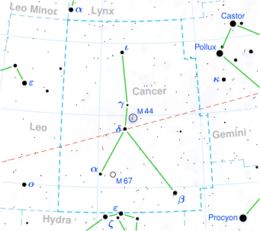Astronomy:X Cancri
| Observation data Equinox J2000.0]] (ICRS) | |
|---|---|
| Constellation | Cancer |
| Right ascension | 08h 55m 22.88194s[1] |
| Declination | +17° 13′ 52.5830″[1] |
| Apparent magnitude (V) | 5.52 – 7.50[2] |
| Characteristics | |
| Spectral type | C-N4.5 C25.5 MS3[3] |
| B−V color index | +2.975±0.039[4] |
| Variable type | SRb[2] |
| Astrometry | |
| Radial velocity (Rv) | −5.0±0.7[4] km/s |
| Proper motion (μ) | RA: −2.076[1] mas/yr Dec.: +6.457[1] mas/yr |
| Parallax (π) | 1.7500 ± 0.0356[1] mas |
| Distance | 1,860 ± 40 ly (570 ± 10 pc) |
| Absolute magnitude (MV) | −4.96[5] |
| Details | |
| Radius | 208[6] R☉ |
| Luminosity | 4,646[6] L☉ |
| Surface gravity (log g) | −0.014[6] cgs |
| Temperature | 3,239[6] K |
| Metallicity [Fe/H] | −0.3[7] dex |
| Other designations | |
| Database references | |
| SIMBAD | data |
X Cancri is a variable star in the northern constellation of Cancer.[8] It has a red hue and is visible to the naked eye at its brightest. The distance to this object is approximately 1,860 light years based on parallax measurements, but is drifting closer with a radial velocity of −5 km/s. It lies very close to the ecliptic and so is subject to lunar occultations.[9]

John Birmingham reported that the star's brightness was probably variable, in 1871.[11] In 1895, Thomas Espin confirmed that it is in fact a variable star.[12] It was listed with its variable star designation, X Cancri, in Annie Jump Cannon's 1907 work Second Catalog of Variable Stars.[11] This is a semiregular variable star of subtype SRb that ranges in brightness from visual magnitude 5.52 down to 7.50 with a period of 193 days.[2] Fourier analysis has shown that the star also pulsates with periods of 350 and 1,870 days.[13]
This object is a carbon star – an aging red giant star on the asymptotic giant branch that has a higher abundance of carbon than oxygen in its atmosphere[5] – and is one of the brightest carbon stars in the sky.[14] It has a carbon star spectral classification of C-N4.5 C25.5 MS3.[3] The first C indicates that it is a carbon star, and the N5 that it is a fairly cool strongly red AGB star. The C2 index indicates the strength of the Swan bands on a scale of one to eight, which shows the relative abundance of carbon vs oxygen. The MS index, not to be confused with an MS spectral class, indicates the strength of the SiC2 bands on a scale of one to seven. These bands are thought to be very sensitive to temperature.[15]
The angular diameter of X Cancri has been measured using both lunar occultations and very long baseline interferometry, both methods giving a diameter around 8 mas.[16]
References
- ↑ 1.0 1.1 1.2 1.3 1.4 Vallenari, A. et al. (2022). "Gaia Data Release 3. Summary of the content and survey properties". Astronomy & Astrophysics. doi:10.1051/0004-6361/202243940 Gaia DR3 record for this source at VizieR.
- ↑ 2.0 2.1 2.2 Samus, N. N. et al. (2017), "General Catalogue of Variable Stars", Astronomy Reports, 5.1 61 (1): 80–88, doi:10.1134/S1063772917010085, Bibcode: 2017ARep...61...80S.
- ↑ 3.0 3.1 Barnbaum, Cecilia et al. (1996), "A Moderate-Resolution Spectral Atlas of Carbon Stars: R, J, N, CH, and Barium Stars", Astrophysical Journal Supplement 105: 419, doi:10.1086/192323, Bibcode: 1996ApJS..105..419B.
- ↑ 4.0 4.1 Anderson, E.; Francis, Ch. (2012), "XHIP: An extended hipparcos compilation", Astronomy Letters 38 (5): 331, doi:10.1134/S1063773712050015, Bibcode: 2012AstL...38..331A.
- ↑ 5.0 5.1 Guandalini, R.; Cristallo, S. (2013), "Luminosities of carbon-rich asymptotic giant branch stars in the Milky Way", Astronomy & Astrophysics 555: 7, doi:10.1051/0004-6361/201321225, A120, Bibcode: 2013A&A...555A.120G.
- ↑ 6.0 6.1 6.2 6.3 McDonald, I.; Zijlstra, A. A.; Watson, R. A. (2017), "Fundamental parameters and infrared excesses of Tycho-Gaia stars", Monthly Notices of the Royal Astronomical Society 471 (1): 770, doi:10.1093/mnras/stx1433, Bibcode: 2017MNRAS.471..770M.
- ↑ Lambert, David L. et al. (October 1986), "The Chemical Composition of Carbon Stars. I. Carbon, Nitrogen, and Oxygen in 30 Cool Carbon Stars in the Galactic Disk", Astrophysical Journal Supplement 62: 373, doi:10.1086/191145, Bibcode: 1986ApJS...62..373L.
- ↑ 8.0 8.1 "X Cnc". SIMBAD. Centre de données astronomiques de Strasbourg. http://simbad.u-strasbg.fr/simbad/sim-basic?Ident=X+Cnc.
- ↑ Schmidtke, P. C.; Africano, J. L. (January 2011), "KPNO Lunar Occultation Summary. III", The Astronomical Journal 141 (1): 7, doi:10.1088/0004-6256/141/1/10, 10, Bibcode: 2011AJ....141...10S.
- ↑ Percy, John R.; Wilson, Joseph B.; Henry, Gregory W. (August 2001), "Long-Term VRI Photometry of Small-Amplitude Red Variables. I. Light Curves and Periods", Publications of the Astronomical Society of the Pacific 113 (786): 983–996, doi:10.1086/322153, Bibcode: 2001PASP..113..983P.
- ↑ 11.0 11.1 Cannon, Annie J. (1907). "Second catalogue of variable stars". Annals of Harvard College Observatory 55: 1–94. Bibcode: 1907AnHar..55....1C. https://articles.adsabs.harvard.edu/pdf/1907AnHar..55....1C. Retrieved 18 December 2024.
- ↑ Espin, T. E. (April 1895). "On the variability of Es.-Birm. 281". Astrophysical Journal 1: 351–352. doi:10.1086/140063. Bibcode: 1895ApJ.....1..351E. https://articles.adsabs.harvard.edu//full/1895ApJ.....1..351E/0000351.000.html. Retrieved 23 December 2024.
- ↑ Kiss, L. L.; Szatmáry, K.; Cadmus, R. R.; Mattei, J. A. (1999), "Multiperiodicity in semiregular variables. I. General properties", Astronomy and Astrophysics 346: 542, Bibcode: 1999A&A...346..542K.
- ↑ Upgren, A. R. (February 1973), "The Parallax and Proper Motion of the Carbon Star X CANCRI", Astrophysical Journal 179: L121, doi:10.1086/181130, Bibcode: 1973ApJ...179L.121U.
- ↑ Keenan, Philip C. (1993), "Revised MK Spectral Classification of the Red Carbon Stars", Publications of the Astronomical Society of the Pacific 105: 905, doi:10.1086/133252, Bibcode: 1993PASP..105..905K.
- ↑ Richichi, A.; Percheron, I. (2002), "CHARM: A Catalog of High Angular Resolution Measurements", Astronomy and Astrophysics 386 (2): 492–503, doi:10.1051/0004-6361:20020236, Bibcode: 2002A&A...386..492R.
 |

